THE GIFT OF KNOWLEDGE OVERMANTEL
CRANBROOK CAMPUS LIBRARY
1927 - 1928
Carved limestone (115 x 162 inches overall)
GÉZA MARÓTI (Artist)
Born March 1, 1875, Červený, Hrádok, Slovakia; died May 6, 1941, Budapest, Hungary
Cranbrook Center for Collections and Research, Cultural Properties Collection, Cranbrook School (CS 37)
Gift of George Gough Booth and Ellen Scripps Booth, 1927
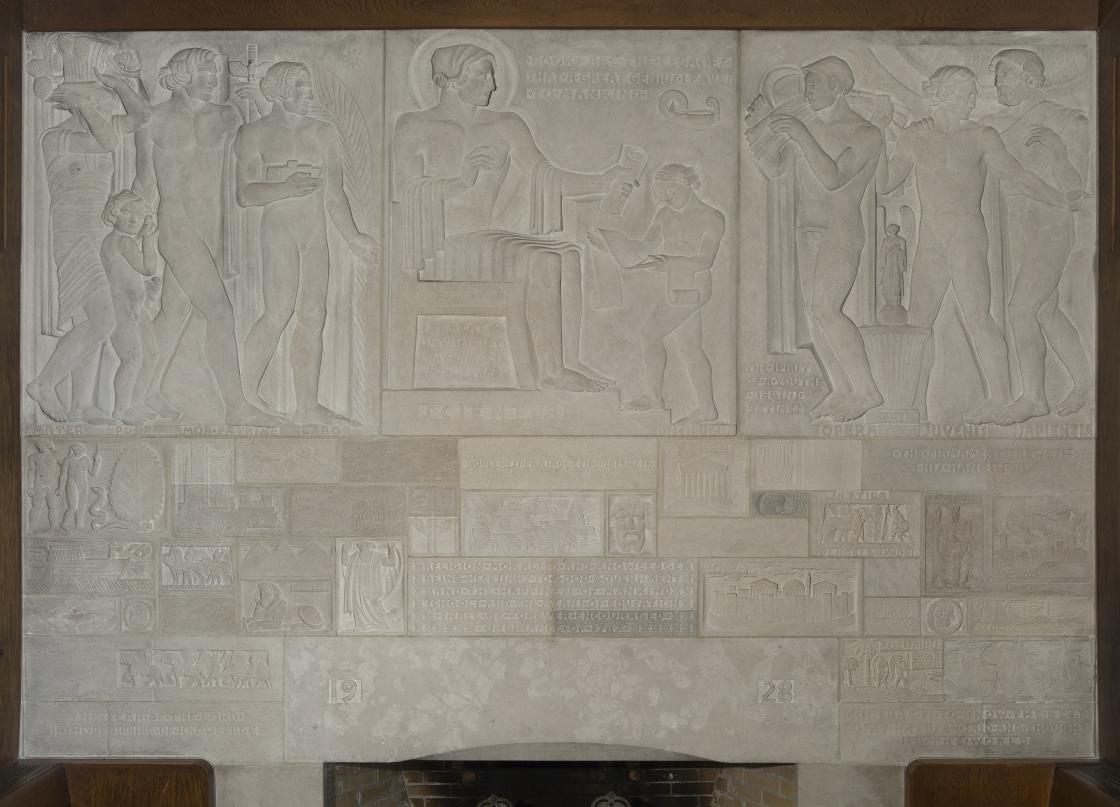
The Gift of Knowledge: A Witty History Puzzle for Growing Youth
In a niche on the north end of the Cranbrook Library Reading Room, one finds a floor to ceiling limestone panel carved in bas relief (meaning the figures are clearly visible but not too deeply cut) surmounting the fireplace. This work is known as The Gift of Knowledge. The space that frames The Gift of Knowledge is like a cozy corner. To the right and left are reading benches perfect for curling into and lit by windows above admitting the east and west light.
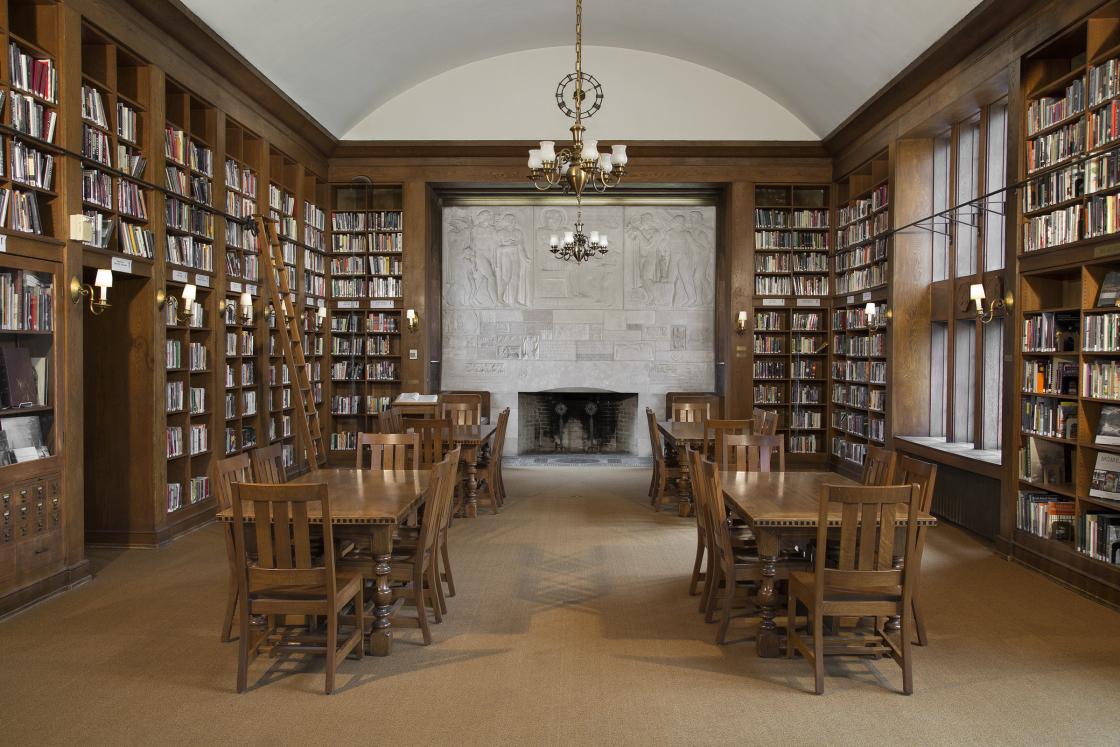
Readymade Perspective View
For a proper place to study the totality of The Gift of Knowledge, however, the viewer should stand just at the threshold of the niche space by the bookcases, a point far enough away from it for taking in the entire panel.
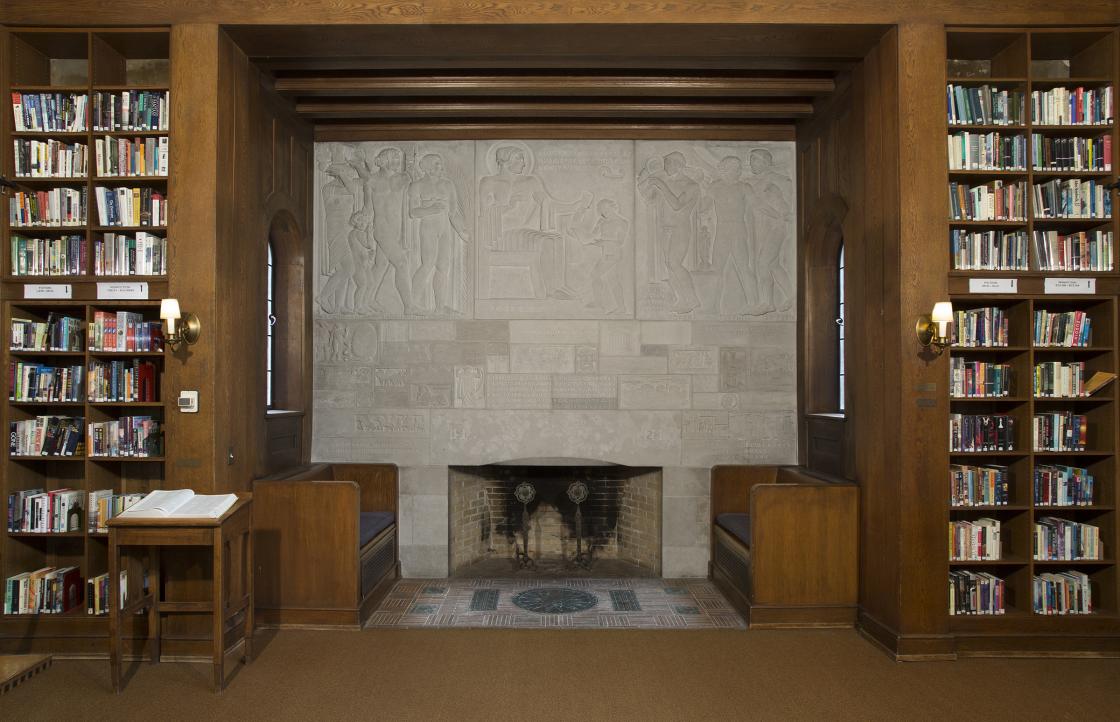
Original Conception
Hungarian architect and sculptor Géza Maróti designed The Gift of Knowledge in 1927. Photographs in a Birmingham publication, titled The Afterglow (September 1927), show the completed concept in model form at just the time Cranbrook School for Boys was to open in September 1927. The sculpture was completed by the fall of 1928.
Although no program for this project has survived, the reporter for The Afterglow provided a description of the model. The sculptor intended “to appeal to the young mind and taste” and to give every detail “a lively and versatile thought which immediately holds the interest of the lad, commands his admiration, and stimulates his mind in the direction of history and the cultural subjects.” Sensuously rendered in a richly carved gray limestone, the design of The Gift of Knowledge provided an opportunity for creating for the eager young mind an intense encounter with two topics: family aspirations and the meaning of history. The writer for The Afterglow penned this description:
An example is the fireplace for the library, with the design in relief, with Knowledge at the top of the center and figures of Youth, and Mother and Child, on either side. Below, in smaller and lower relief, are pictures depicting human history, from the time of Adam and Eve down to the voyage of Columbus. Between these symbolical figures are small tiles reserved for mottoes appropriate for the library.
The Finished Overmantel, a Provocative Puzzle for Teaching
This description goes a distance in characterizing the original scenario. Of course, in its finished state, The Gift of Knowledge offered a kind of puzzle intended to provoke more questions than it answered. Truth be told, to enter into its mysteries requires not only interest but also empathy for its combination of imagery, art references, humor, and religiosity. Such interest and empathy are a lot to ask of a senior in high school and they may challenge the capacities of a 7th -, 8th-, or 9th-grade student. These three grades started out in that first year at Cranbrook School. Grade 10 was added in 1928, the 11th grade in 1929, and 12th in 1930.
Did history teachers at the school ever use The Gift of Knowledge as a text in the curriculum or as an agent for stimulating class discussions? Perhaps alumni would have stories to tell on this question?
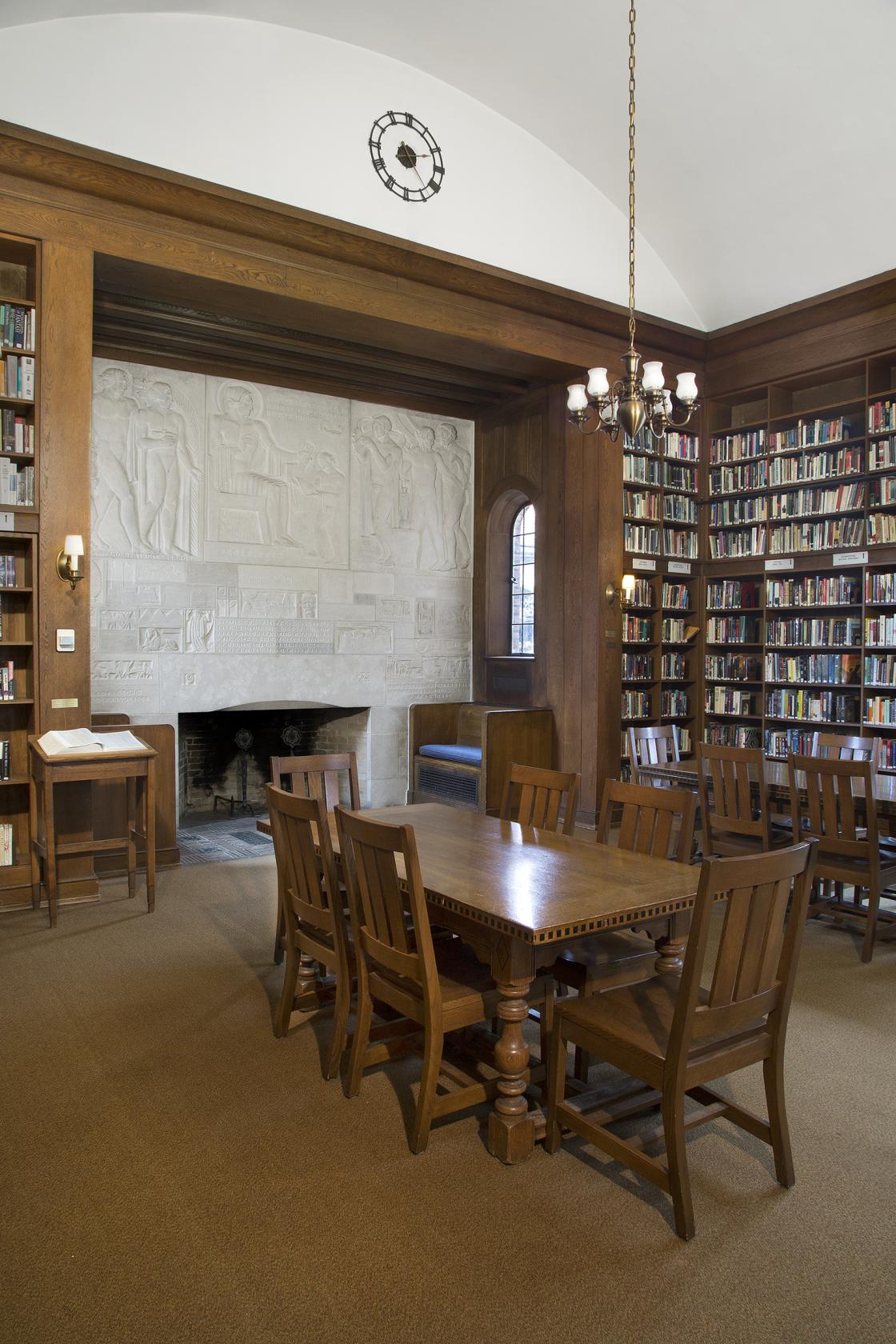
Highlights of The Gift of Knowledge
What follows is an analysis of The Gift of Knowledge. It is undertaken with the assumption that in this limestone panel a coherent, richly nuanced three-part story provides an insight into the spirit and founding ideas of Cranbrook School for Boys.
The Coming of Age Triptych Across the Top
Three scenes across the top of the overmantel depict Childhood, Late Adolescence, and Entering a Wider World. The story reads from left to right. But movement in the side panels is toward the central one, which depicts a young man stepping up to receive a scroll-like diploma from an erect figure in a stately chair. The movement of climbing the steps to receive the diploma is upward from right to left but the figure in the chair contains this movement within the pane. Thus, the focus on the central scene, Receiving the Diploma, organizes the triptych as a celebration of education as a “gift of knowledge.”
Interpretation: Eye Opening Art
Cranbrook architect, Eliel Saarinen, made note of the fact that Founder George Booth wanted “eye-opening architecture.” Indeed, creating a vivid imprint of visual impressions on youthful minds permeated every design for the educational mission of Cranbrook School for Boys and equally for all of Saarinen’s plans and buildings at Cranbrook.
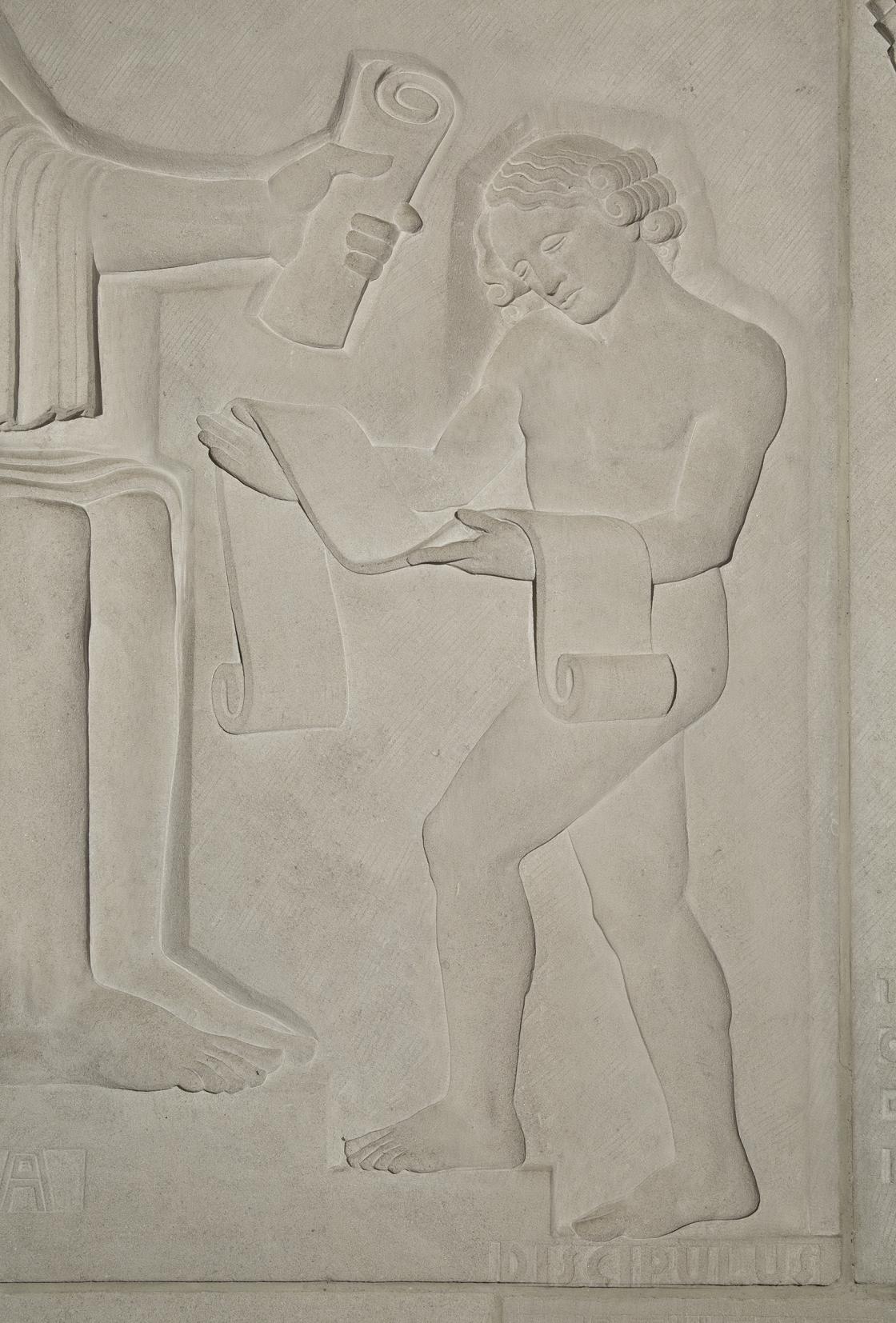
On the Left Side, The Family
The concept “Eye-opening” as applied to The Gift of Knowledge directs attention to the eyes of youth as opposed to the eyes of adult people. The eyes of the child on the left are closed as he listens to the heartbeat of a dove. One bird is held in the child’s grip while its companion flies in alarm nearby. In contrast, the adult figures in the scene—mother, bearing grapes, and father, with staff, both following the figure holding an ocean liner in the crook of his arm and a palm frond—proceed forward with eyes wide open, ready to encounter the future
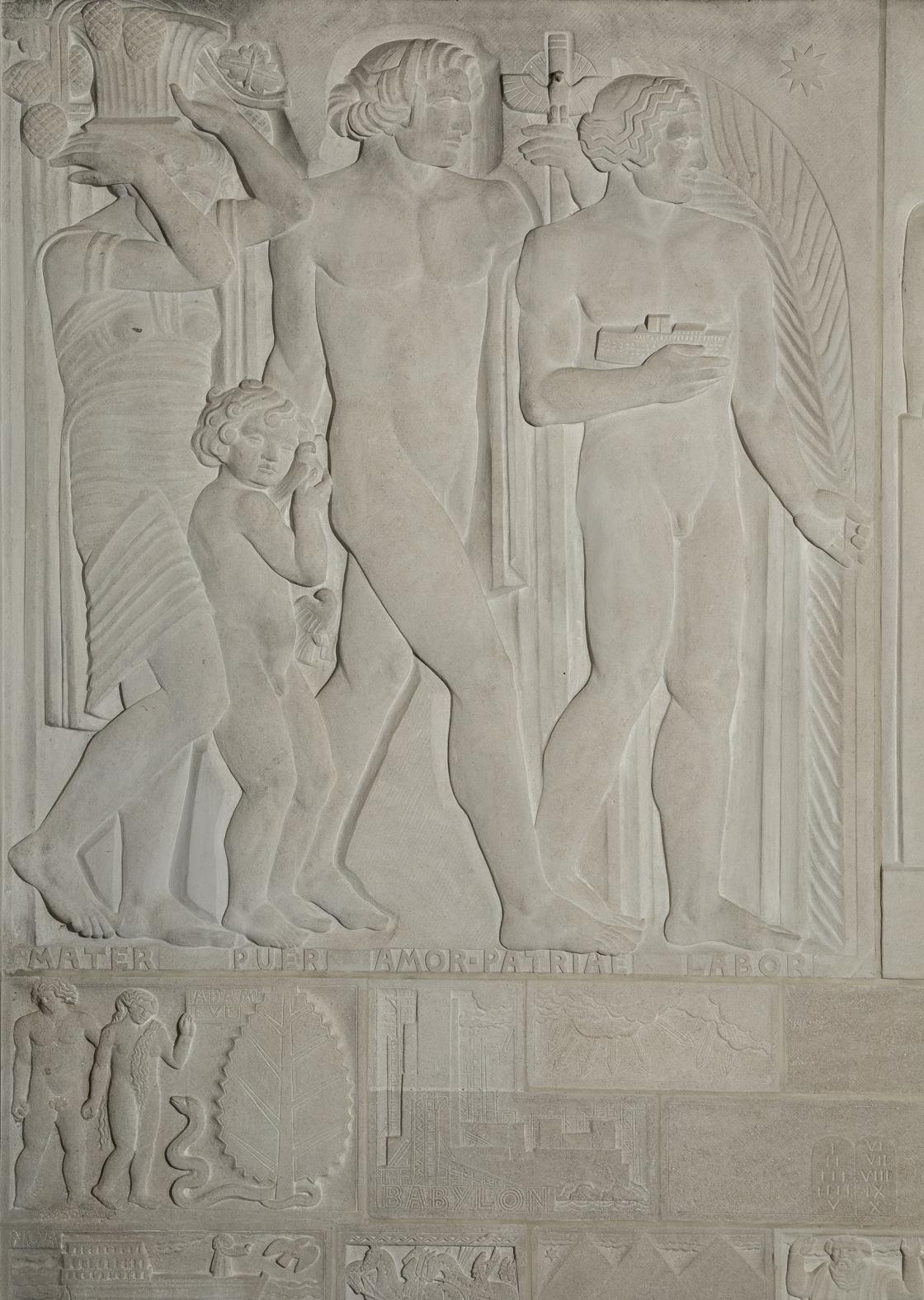
On the Right Side, Entering a Wider World
In the pane on the right, the young man entering a wider world is guided forward by a venerable figure (the architect) holding a compass. Both are led by a figure bearing a scythe and sheaf of wheat, the scene unfolding under a burning sun. The eyes of the adult watchers look straight ahead while the young man’s head turns back, expressing with his backward reaching arm the last glimpse and move to grasp something he is leaving behind. The young man’s deeply cut eyebrow hides the eye in shadow, suggesting loss, possibly regret, but also indicating the arrival of a new self-awareness. The winged spirit on the fluted vase pedestal evokes an additional presence: a consciousness of the spirit of creativity and craftsmanship.
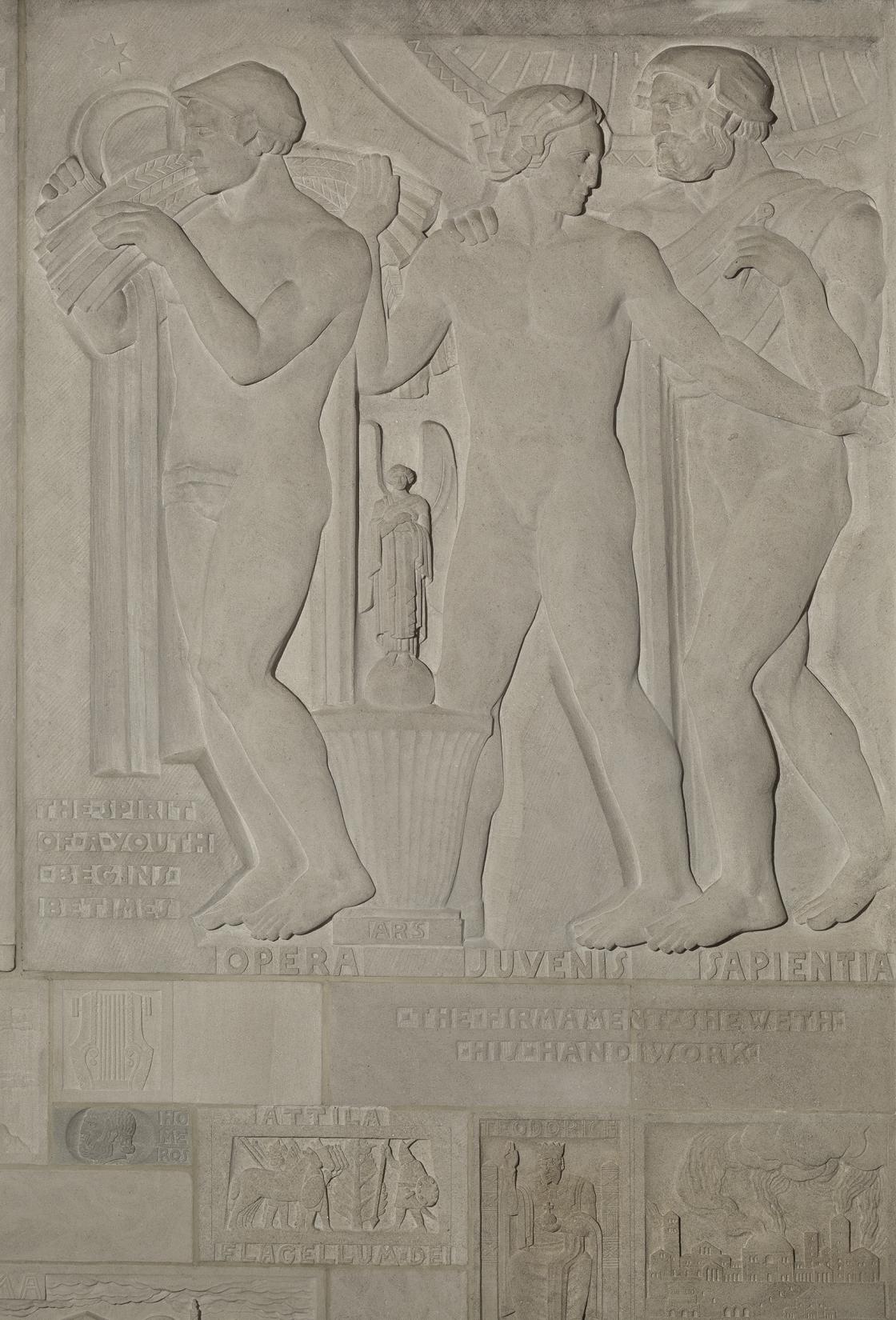
Receiving the Diploma
The central scene shows the graduate stepping up to receive the extended diploma in spite of the fact that his eyes are cast down at his book. This sleep-walking youth appears to be oblivious to the recognition that awaits him, deeply involved in his own interests and pleasures though definitely on his way. The heads of the three figures—child, youth, young man—tracked from left to right indicate a graceful upward curve.
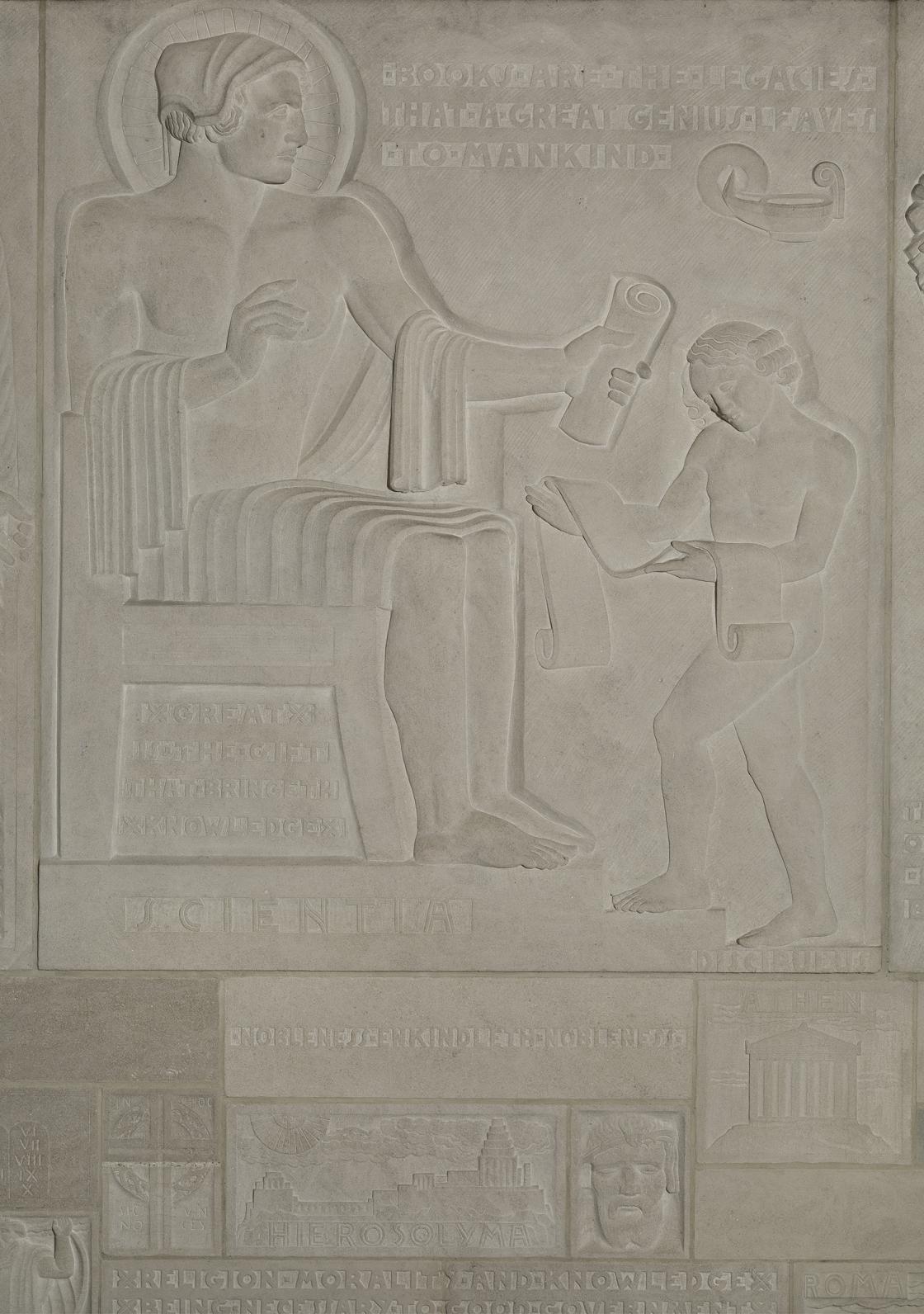
Liberty Cap
A last comment involves the caps worn by the architect, the wheat bearer and the diploma giver. These caps refer to the “Phrygian Cap” that for a time identified sympathizers with the French Revolution, which overthrew kings and elevated the workingman. The Phrygian cap was used in paintings and in early American coinage for a number of years to show solidarity with the French readiness to fight for freedom from tyranny. As employed in The Gift of Knowledge, the suggestion is freedom for rather than freedom from—for freedom of self-expression, for freedom of inquiry, for freedom of opportunity.
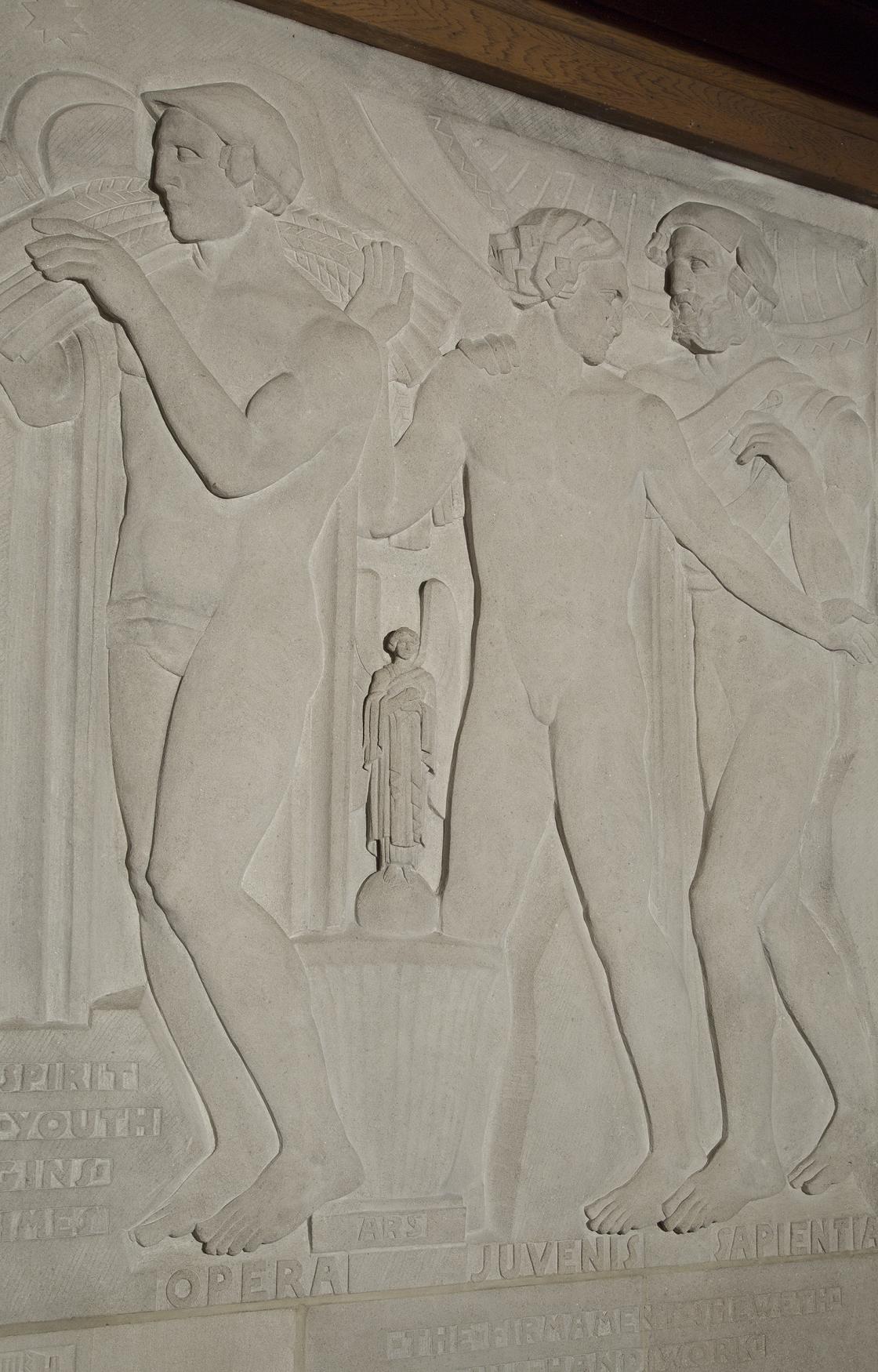
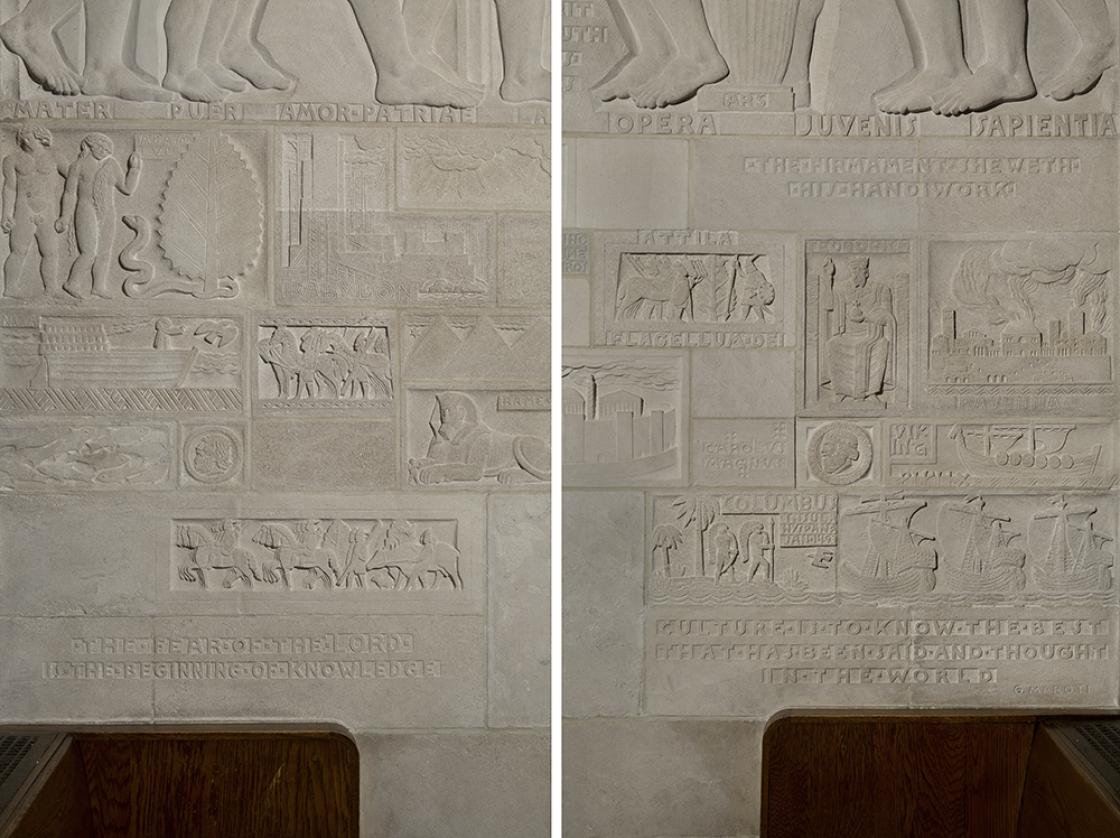
The History of the World
The secret of this history of the world resides in the linkage between the release of the dove by Noah on the left and the arrival of the dove on the island of Hispaniola on the right. This is an example of prolepsis (the embodiment in a present sign of an event that is anticipated in the future)—in this case, the act of releasing the dove presupposed Columbus’s discovery of the New World. Once understood and accepted, this rendering of Divine presence in human affairs would have turned every historical event into a steppingstone on a foreordained path to American ascendancy in the 20th century. And, indeed, the humor and the unexpected selections of focus in this history of the world offer a rich intellectual interface.
Two Examples
Humor: Géza Maróti’s depiction of the Tower of Babel perhaps makes light of the failure of American businessmen to build Eliel Saarinen’s second-place prize-winning skyscraper. Eliel Saarinen’s proposed design for the Chicago Tribune Tower Competition of 1922 far outclassed the winning design in the eyes of most critics. Even more problematic, Eliel Saarinen’s second place design immediately changed the design of skyscrapers across the United States. One can see this right in Detroit, in the Maccabees Building and in the Fisher Building. To present the Tower of Babel as a modern skyscraper beset by lightning links the Biblical story of human tongues in conflict with this modern American/Cranbrook-oriented story pointing to Eliel Saarinen’s design that no one built but everyone copied. Long-time friends, Saarinen brought Maróti to Cranbrook in early 1927 to help with the sculptural ornamentation of Cranbrook School for Boys.
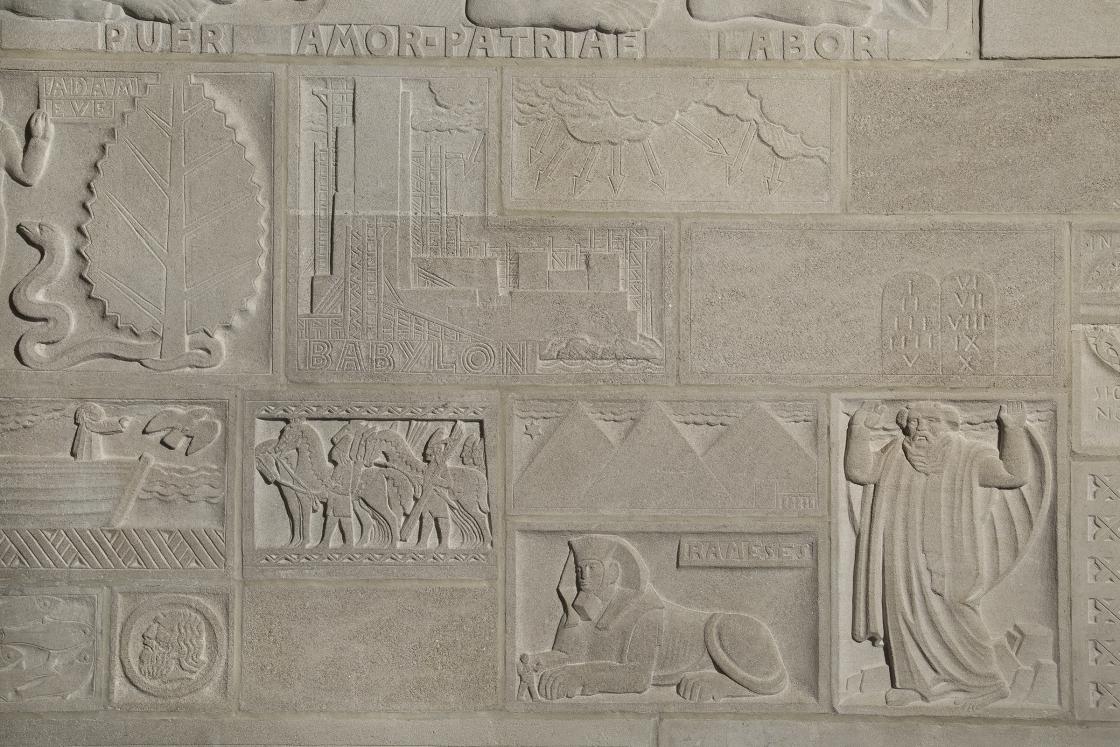
Historical Readings: The treatment of Attila the Hun on the wall points to the conjecture that if Atilla had not invaded the Roman empire when he did, then England could not have come into being the way it did, and, of course, without England there would be no British North America, no United States, and no George Booth and Cranbrook.

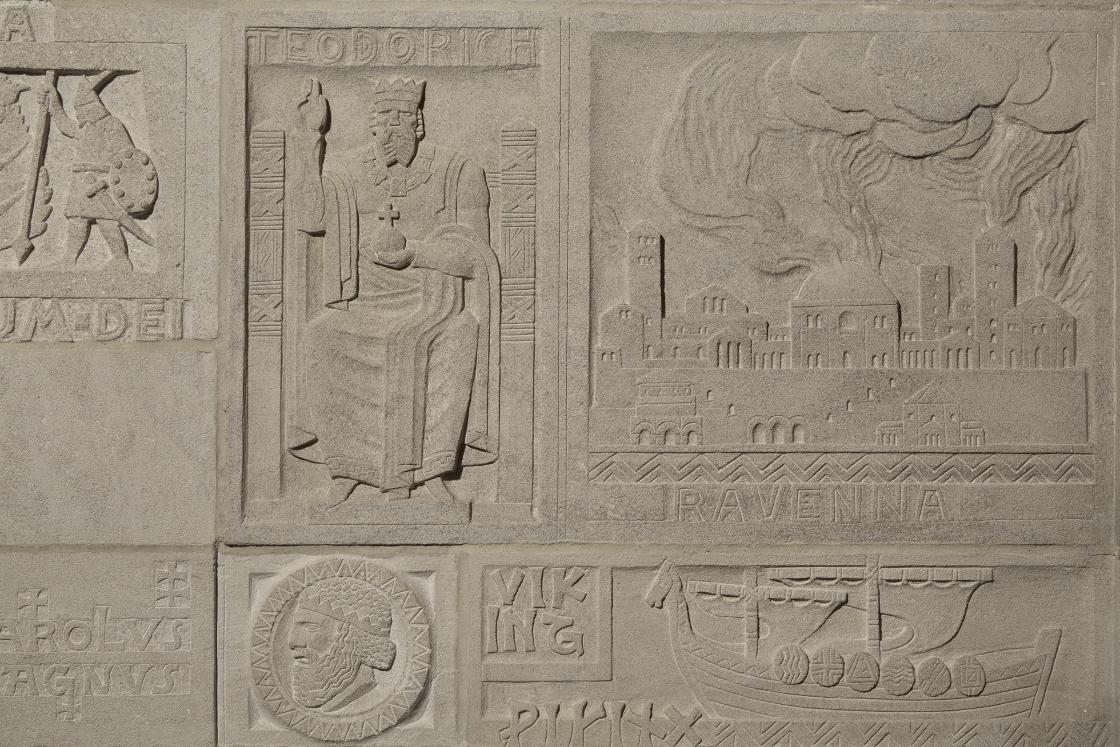
But even more interesting is the presence of Theodoric the Great as a featured historical actor. He is given a presence on the overmantel far more visible than Charlemagne’s. As Theodoric is associated with the Fall of Rome, and as he located his center of action in Ravenna, one looks for clues as to why he is given so much attention.
Theodoric was German, but he ruled in harmony with Roman law. He was a builder and also a restorer of Classical buildings. His mausoleum is a minor wonder of the world. He did not set fire to Ravenna when he laid siege to it, so the representation of Ravenna, with its churches, baptisteries, and Theodoric’s palace and mausoleum in flames has to be symbolic of the Fall of Rome. Also, Theodoric, an Arian, found himself declared a heretic by those seeking to displace him and his family. The official date of the Fall of Rome is 476 but Theodoric’s dynasty came to an end in 536. Does this make him an emblem of a longer-surviving Roman empire? Can you hear this instruction: “Okay, class, you have a paper due a week from Friday—The topic: When do you think the Roman empire came to an end?”
There are many other wonderful elements in this history of the Western world to negotiate with. The many quotations all can be traced and most of the images have precedents, though turning Moses into a weightlifter of the Ten Commandments, one stone book held up in each hand, seems pretty unprecedented.
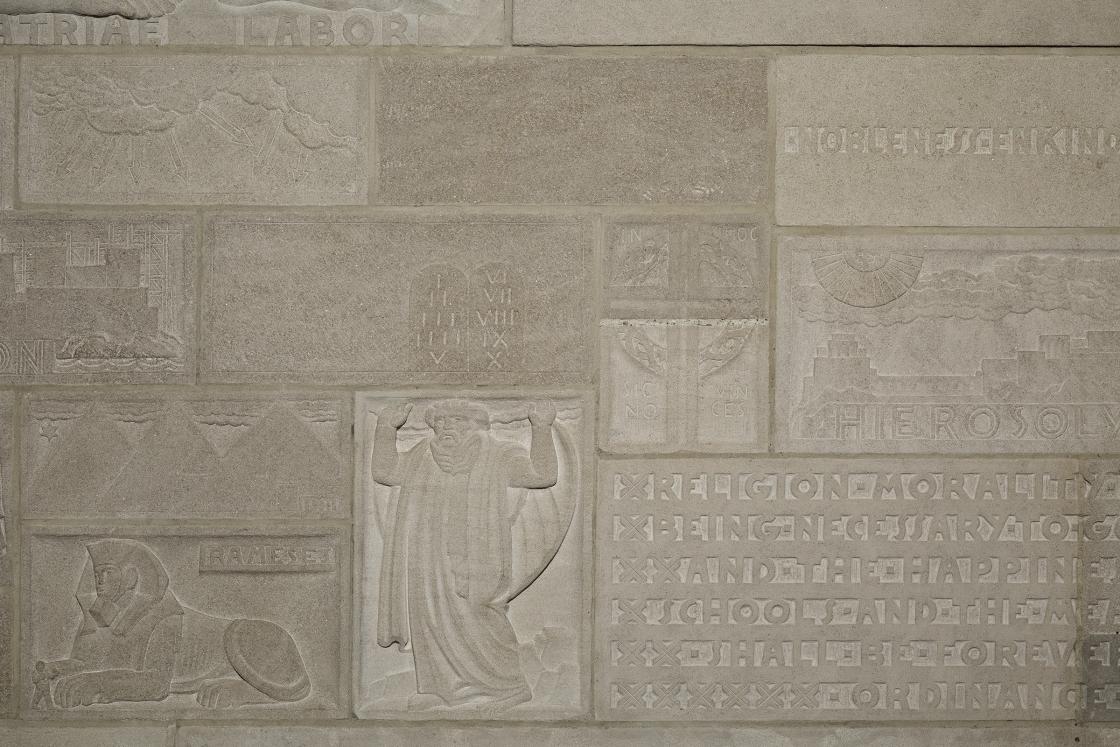
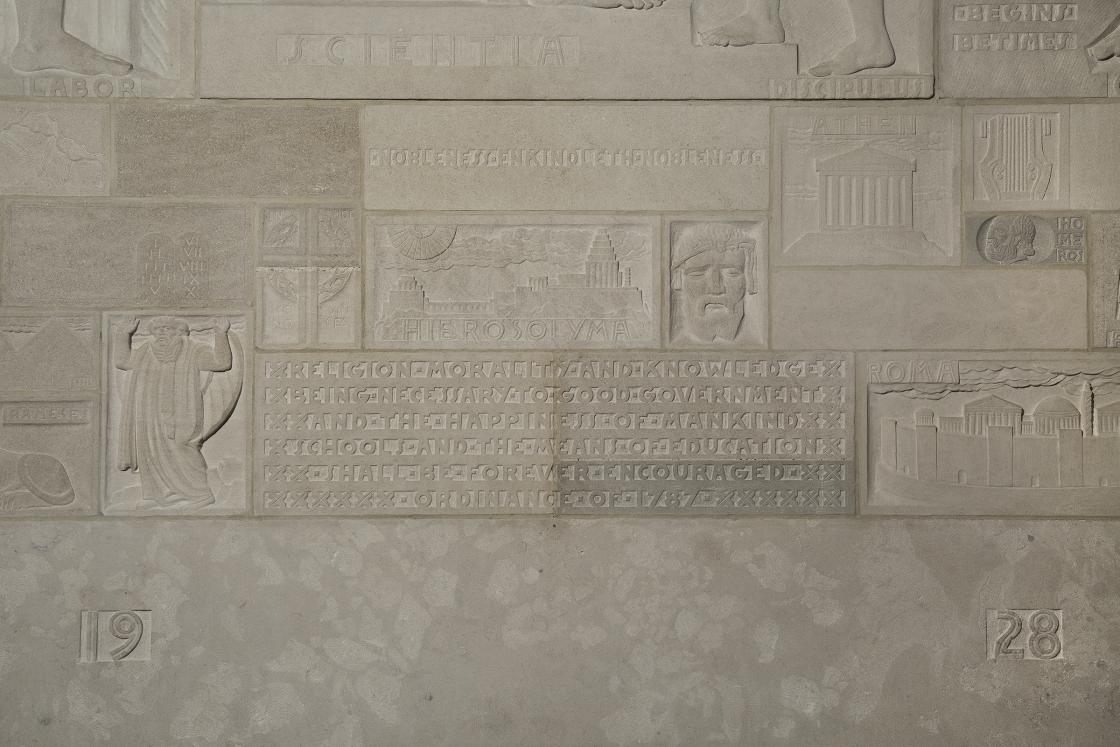
The third element of The Gift of Knowledge fills the rectangle at the top of the fireplace, just at eye level, where it is easy to read. The quotation comes from the Northwest Ordinance of 1787, written by Thomas Jefferson. The piece of the sentence quoted promises that the State will make every effort to provide an education to each citizen:
Religion, morality and knowledge being necessary for good government and the happiness of mankind, schools and the means of education will be forever encouraged
This quotation linked Cranbrook School for Boys to the University of Michigan, where sometime after 1873 this quotation was painted over the proscenium arch in the 3,000-seat auditorium in University Hall. After Angell Hall was built to replace University Hall in 1925, the quotation was brought outside and cut into the pediment of the new building on State Street. It is also not incidental that the Northwest Ordinance prohibited the spread of slavery to the Northwest Territory. Abraham Lincoln, in his successful bid for the Presidency, used the Northwest Ordinance as decisive proof that the Founding Fathers believed their government could and should control slavery.
Summation of the Story of The Gift of Knowledge
These three elements—the family sending the child to school in preparation for a productive life; the history of the world in which America becomes the last, best hope of mankind; and the quotation from the Northwest Ordinance of 1787, whose embrace includes concepts of public education and the direct rebuke of slavery as well as directions for turning a territory into a state—make up one theme: The Gift of Knowledge. In this case in particular, telling the story in limestone relief provided an occasion to students for enlightenment, for debate, and for personal delight.
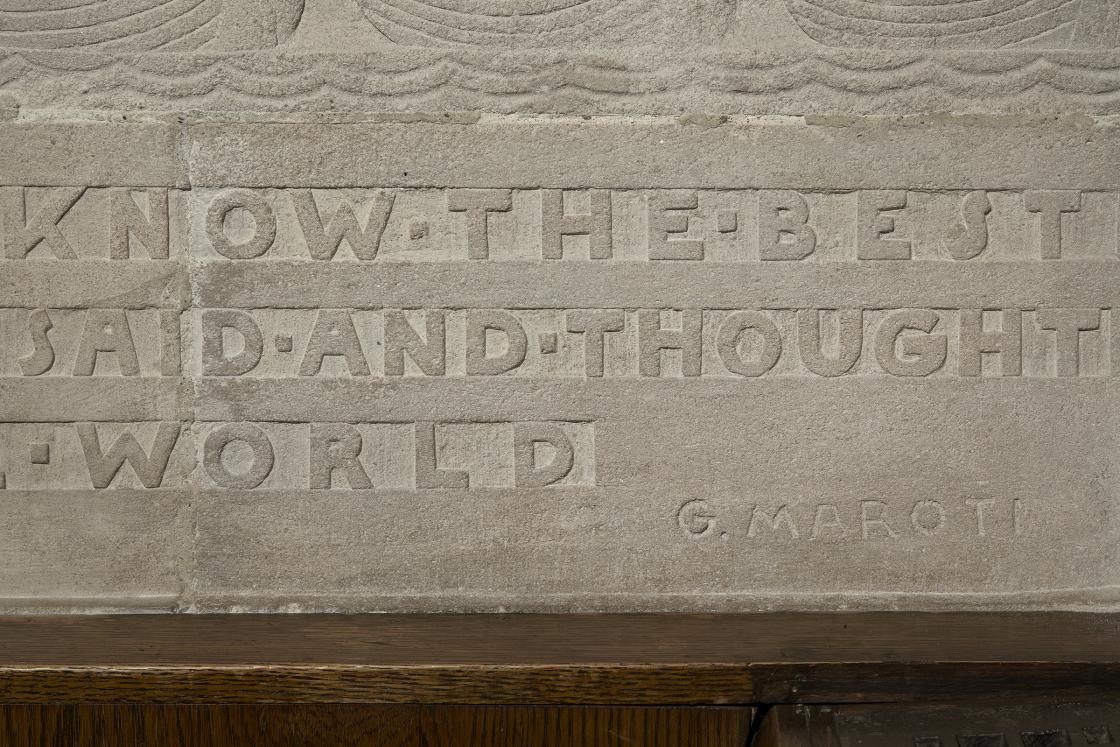
An Extraordinary Gift to Cranbrook, to the State, to the Nation
In the trust agreement for the Cranbrook Foundation, George Booth arranged for the University of Michigan to receive the property of Cranbrook in the eventuality that the community could not continue. He did this before the Great Depression descended, a national catastrophe that no one could have predicted. In these times, as the gifts given by the founders receive recognition and prompt belated expressions of thanks, The Gift of Knowledge should take its place among the most extraordinary creations to burst forth from George Booth’s enthusiasm for the future of the United States, his adopted home. He invited many creative people to help him build an eye-opening educational community—this they did and continue to do.
Jeffrey Welch
Retired Faculty Member, Cranbrook Schools (1977 – 2015)
April 2019
PHOTO CREDITS
Color Photography by P.D. Rearick (CAA ’10), April 19, 2019. Courtesy Cranbrook Center for Collections and Research.
